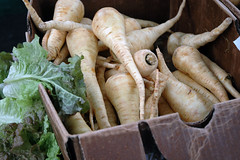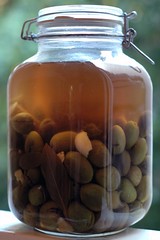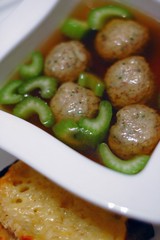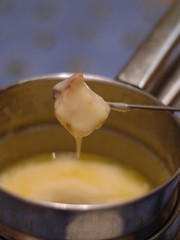Melissa and I don't always agree on the ice cream flavors that should go into the Glace-A-Tron 6000, but mint chip sits high in each of our pantheons of favorite combinations.
My go-to ice cream book, Cook's Illustrated's old How to Make Ice Cream, has a recipe for mint chip ice cream: Make the normal custard base and add crème de menthe and chocolate chips. The easy instructions produce a better version of the supermarket staple.
Where's the fun in that? I wanted to depart from the standard and produce an ice cream alive with the taste of fresh mint and chock full of flavorful chocolate.
In my first batch, I plucked mint leaves from a thick bundle of stems, placed them into a plastic bag, and pounded them with a meat mallet to bruise the leaves and release the oils. I placed the leaves into the milk and cream and proceeded to make the ice cream, leaving the mint in the custard as it chilled overnight. This simple technique created a minty ice cream, but the long steeping time also pulled out earthy, vegetal components from the leaves. These were less welcome flavors.
For the second batch, I bruised the leaves as before, placed them into a pot with the milk and cream, and brought the liquid to a boil. I turned off the heat, let the pot cool to room temperature, and then brought the liquid to a boil once again. I let it cool to room temperature again, strained out the mint leaves, and used the infused milk and cream for making the ice cream. This double-infusion process takes much longer, but the final ice cream had a fresh mint flavor with just a tiny hint of the vegetal character that I disliked the week before.
Parallel to my mint experiments, I toyed with the chocolate chips. Don't tell anyone, but I've become a chocolate snob. I turned up my nose at the bags of Nestle chips in the store and bemoaned the death of Scharffen Berger's "Chocolate Chunks" product, morsels of chocolate that didn't catch on in time to justify the expense of making them.
I decided to make my own version of this bygone product. I melted down bittersweet Scharffen Berger bars, re-tempered the chocolate (poorly, I might add), and spread it into a wide, thin strip. Once it cooled, I chopped the slab into small chunks and added them to the ice cream as it finished churning. This worked well, and I used the leftover chunks to make chocolate chip cookies. David Lebovitz, spying Melissa's picture and her description of my efforts, commented that I probably didn't need to temper the chocolate. I didn't need to worry about a higher melting point for ice cream-bound chips, he pointed out, and the untempered chocolate would be softer in texture and flavor. I tried the straightforward melt-and-cool technique for my second batch of ice cream, and I decided that David was right. I like the perverse idea of an impossibly difficult mint chip ice cream, but these chips were a better fit for the ice cream.
Wine Notes
I don't like to serve wine with ice cream. By the time the cold has numbed your taste buds and the cream and egg yolks have coated your tongue with an impenetrable shield of fat, any subtlety in the wine has disappeared. What To Drink With What You Eat has an entry for ice cream in general, and of the listings, Muscat de Beaumes-de-Venice, a Southern Rhône dessert wine, makes the most sense. It has an assertive flavor that will stand up to the taste-numbing aspects of ice cream, and its acidity can combat the fat coating your tongue.
Labels: Culinary Explorations, Technique





 Insightful nuggets speckle the slim book
Insightful nuggets speckle the slim book 


